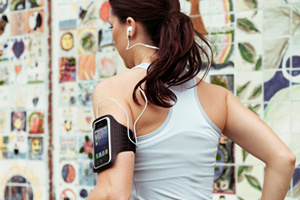Running Injuries Related to Electronic Devices

An increasingly number of people are running with their smart phones, music devices etc attached to their upper arm. Recent researches suggest that running with a smart phone or another electronic device attached to the upper arm might be the cause of an increase in number of injuries to the hip muscles. The hip muscle groups are particularly important because they have been implicated in a range of running injuries and the researchers argue for a correlation between the use of electronic devices in exercise and these injuries.

The Science
Hip strength
The first study conducted by Niemuth et al., looked at hip strength in runners visiting an orthopedic clinic for injuries. Thirty runners who had various hip and leg injuries had their hip strength tested in all six directions of motion. Compared to a control group of recreational runners, the runners who normally run with a device on the arm had weaker hip flexors and hip abductors on the side they wear the device, while their adductors were stronger on the injured side. The healthy runners displayed no side-to-side differences in muscular strength. Interestingly, the influence of muscle strength imbalances was stronger for the iPhone users compared to the Android mobile users. No relationship was found between the injured side and the runners’ dominant leg.
Runner’s knee
Another more specific study by Ireland et al. in 2013 found similar results. Like the previous study, hip strength was evaluated fifteen women with patellofemoral joint pain (often known colloquially as “runner’s knee”) and compared with age-matched control subjects. Again, the device using runners had weaker hip abductors as well as weaker hip external rotators on their injured leg compared to a control group. Niemuth and colleagues published a follow-up study on the same subject—female athletes with patellofemoral joint pain—in 2014. Using a better-designed procedure and taking more rigorous measurements, they showed that the runners wearing electronic devices on their upper arms had indeed weaker abductors, as well as being weaker overall in measures of five of the six major hip muscle groups compared to other runners.
Limitations
These studies are very promising, but they all have a similar weakness: they are retrospective, meaning they only look at runners after they get injured. The jury’s still out on whether removing the device from the arm will prevent injury, but there’s good circumstantial evidence, and most orthopedic doctors would highly recommend it.
Read the full article here.

Don’t trust posts published on April the 1st.